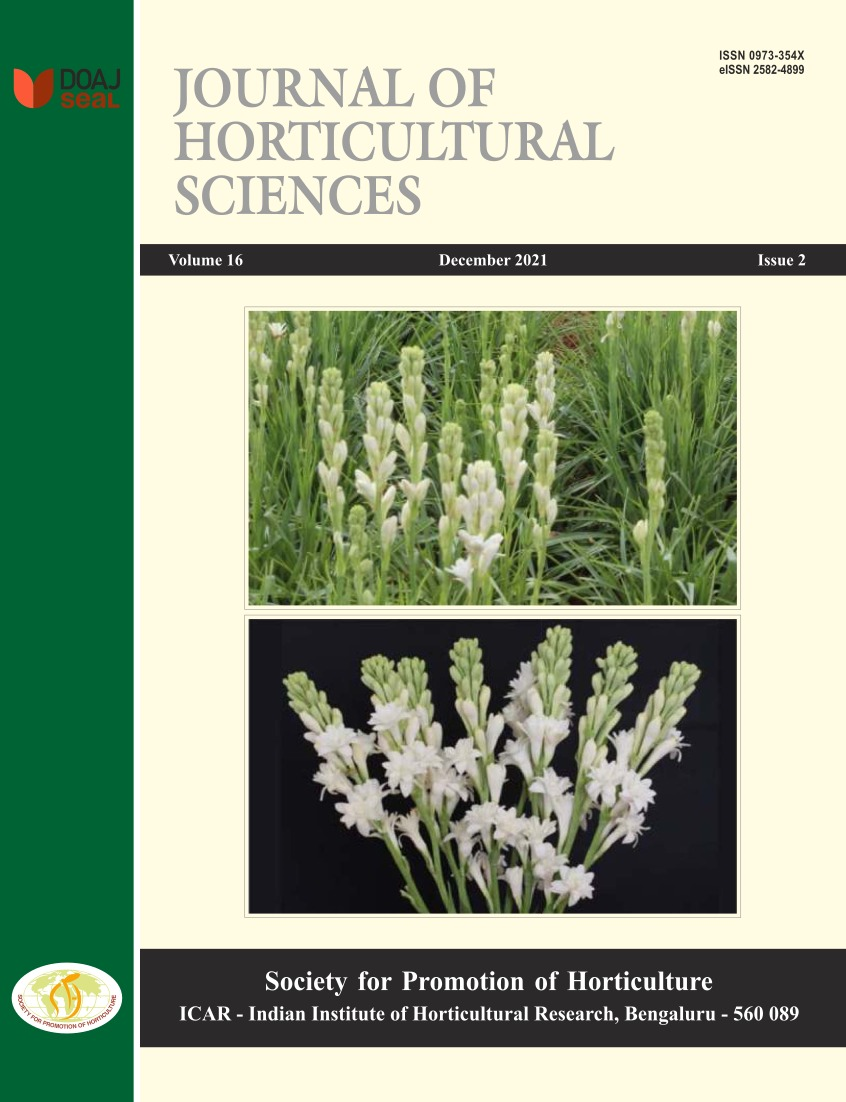Assessment of soil and water quality status of rose growing areas of Rajasthan and Uttar Pradesh, India
DOI:
https://doi.org/10.24154/jhs.v16i2.838Keywords:
Rajasthan, rose, Soil quality, Uttar Pradesh, water qualityAbstract
Rose is a commercial flower crop widely grown across India. It is highly sensitive to salinity and alkalinity. In the process of identification of salt and alkalinity resistant rootstocks of rose cultivars, a survey was conducted in the rose growing areas of Uttar Pradesh (UP) and Rajasthan. Total of 28 representative surface soil samples were collected from rose fields of these regions, processed and analyzed for the soil quality parameters. Similarly water samples (20 samples) from the bore wells of these fields were collected and analyzed. The results revealed that most of the soils of rose growing fields in UP were alkaline (pH >8.0) with normal salt content (electrical conductivity, EC < 0.5 dS m-1). Many of these soils also had higher bicarbonates (> 3 meq 100 g-1). In case of Rajasthan, few samples had higher pH, EC, chloride (>2 meq 100 g-1) and bicarbonate contents. Exchangeable sodium percentage (ESP) of UP and Rajasthan samples ranged from 5.21-20.7% and 2.94-24.9%, respectively. In case of water parameters in these areas, pH was slightly in alkaline range, EC of some of the samples were high (>1 dSm-1). Sodium content was slightly higher than other cations. Soluble sodium percentage (SSP) of water samples was also slightly higher than normal range (0-50%). Few samples had slightly higher chloride above the threshold limit. From the results, it is concluded that soil and water quality of the rose growing areas of UP and Rajasthan is marginal and proper management/reclamation measures need to be carried out for sustaining the production system.
Downloads
References
Ayers, R.S. and Westcot, D.W. 1985. Water quality for agriculture. FAO Irrigation and Drainage Paper. 29 Rev. 1. Food and Agriculture Organization of the United Nations, Rome.
Bernstein, L., Francois, L.E. and Clark, R.A.1972. Salt tolerance of ornamental shrubs and groundcovers. J. Amer. Soc. Hort. Sci.,97:550– 556.
Brady, N.C. and Weil, R.R.1999. Elements of the Nature and Properties of Soils. 12thed. Prentice Hall. Upper Saddle River, NJ.
Castalanelli, C. 2009. Identifying nutritional deficiencies in the home garden. Western Australian Agriculture Authority, www.agric.wa.gov.au.
Chapman, H.D. 1965. Cation-exchange capacity. In: Black, C.A. (ed.). Methods of soilanalysis -Chemical and microbiological properties. Agron., 9:891-901.
Cox, L. and Koenig, R. 2010. Solutions to soil problems. II. High pH (alkaline soil). Utah State University Cooperative extension series.
Havlin, J., Beaton, J.D., Tisdale, S.L. and Nelson, W.L. 1999. Soil Fertility and Fertilizers: An Introduction to Nutrient Management. 6thed. Prentice-Hall, Upper Saddle River, NJ.
Hong, C.Y., Chao, Y.Y., Yang, M.Y., Cho, S.C. and Huei Kao, C. 2009. Na+ but not Cl– or osmotic stress is involved in NaCl-induced expression of glutathione reductase in roots of rice seedlings. J. Plant Physiol.,166:1598–1606.
Jones, J.B. 2012. Plant Nutrition and Soil Fertility Manual. 2nd ed. CRC Press. Boca Raton, FL. Joshi, D.M., Kumar, A. and Agrawal, N. 2009. Assessment of the irrigation water quality of river Ganga in Haridwar District. Rasayan J. Chem.,2: 285–292.
Mandal, A.K., Obi Reddy, G.P. and Ravisankar, T. 2011. Digital database of salt affected soils in India using Geographic Information System. J. Soil Salinity Water Qual., 3(1): 16-29.
Marschner, H. 1995. Mineral nutrition of higher plants. 2nd ed. Academic Press, San Diego, CA.
Mengel, K. 1994. Iron availability in plant tissuesiron chlorosis on calcareous soils. J. Plant Soil.,165: 275–283.
Miller, J.O. 2016. Soil pH Affects Nutrient Availability. Technical Report, University of Maryland Extension, DOI: 10.13140/RG.2.1.2423.5768.
Motesharezadeha, B., Hesam-Arefia, A. and Savaghebia, Gh.R.2017. The effect of bicarbonate on iron (Fe) and zinc (Zn) uptakes by soybean varieties. Desert.,22(2):145-155.
Munns, R. and Tester, M.2008. Mechanisms of salinity tolerance. Annual Rev. Plant Biol.,59:651-681.
Richards, L.A. 1954. Diagnosis and Improvement of Saline and Alkali Soils. US Salinity Laboratory Staff, US Department of Agriculture, Washington DC.
Sachan, A.K., Arun Kumar, Rajput, M.M. and Arti Katiyar. 2014. Economics of production and marketing of rose flowers in Kannauj district of Uttar Pradesh. Hort.Flora. Res. Spectrum.,3 (1): 29-34.
Shekhawat, D. 2012. A Study of Supply Chain Practices and Marketing Prospects of Rose Flower in Ajmer District of Rajasthan. M.Sc. Thesis. Swami Keshwanand Rajasthan Agricultural University, Bikaner.
Tim, O., “https://www.agril.wa.gov.au/david-hall”“view prafile” Hall, D. and Lemon, J. 2019. Identifying dispersive (sodic) soils. Agriculture and Food, Department of Primary Industries and Regional Development, Government fo
Western Australia. Available online : https://www.agric.wa.gov.au/dispersive and - sodic -soils / identifying - dispersive - sodic - soils.
Tsai, Y.C., Hong, C.Y., Liu, L.F. and Kao, H. 2004. Relative importance of Na+ and Cl– in NaClinduced antioxidant systems in roots of rice seedlings. Physiol. Plantarum.,122:86–94.
Urban, I. 2003. Inûuences of abiotic factors in growth and development, p. 369–374. In: Encyclopedia of rose science. Robert, A.V., Debener, T. and Gudin, S. (eds.). Elsevier Academic Press, San Diego, CA.
White, P.J. and Broadley, M.R. 2001. Chloride in soils and its uptake and movement within the plant: a review. Annals Bot.,88:967–988.
Xu, G., Magen, H., Tarchitzky, J. and Kafkafi, U. 2000. Advances in chloride nutrition of plants. Adv. Agron.,68:97–150.
Downloads
Published
Issue
Section
License
Copyright (c) 2022 Varalakshmi LR, Tejaswini P, Rajendran S, Upreti K K

This work is licensed under a Creative Commons Attribution-NonCommercial-ShareAlike 4.0 International License.
Authors retain copyright. Articles published are made available as open access articles, distributed under the terms of the Creative Commons Attribution-NonCommercial-ShareAlike 4.0 International License, which permits unrestricted non-commercial use, distribution, and reproduction in any medium, provided the original author and source are credited. 
This journal permits and encourages authors to share their submitted versions (preprints), accepted versions (postprints) and/or published versions (publisher versions) freely under the CC BY-NC-SA 4.0 license while providing bibliographic details that credit, if applicable.





 .
. 











